
Ceresiosaurus is an extinct aquatic genus of lariosaurine nothosaurid sauropterygian known from the Middle Triassic of Monte San Giorgio, southern Switzerland and northern Italy. Ceresiosaurus, meaning "Lizard of Ceresio". The type species, Ceresiosaurus calcagnii, was named by Bernhard Peyer in 1931. C. calcagnii is known from both the Cava superiore and Cava inferiore beds of the Lower Meride Limestone at Monte San Giorgio, dating to the latest Anisian of the Middle Triassic. Rieppel (1998) suggested that the back then monospecific genus Ceresiosaurus, is a junior synonym of the better known Lariosaurus, yet he kept it type species as a separate species under the new combination L. calcagnii. In 2004, however, this synonymy was objected by Hänni who described and name a second species of Ceresiosaurus, C. lanzi - a separation supported by several other authors since. This species is known only from the stratigraphically younger Cassima beds of Monte San Giorgio, although also from the Lower Meride Limestone, dating to possibly the lowest Ladinian age. The species in a subtropical lagoonal environment with varying open marine influences, and alongside many related but smaller species of nothosaurids and pachypleurosaurids. Ceresiosaurus represents one of the largest vertebrate of up to 3 m (9.8 ft) snout-tail length from the very diversified paleoenvironment of the Middle Triassic Monte San Giorgio.
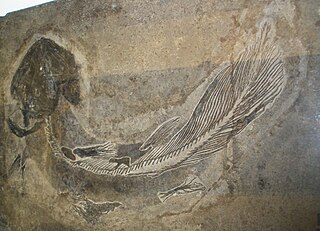
Coelacanthus is a genus of extinct coelacanths that first appeared during the Permian period. It was the first genus of coelacanths described, about a century before the discovery of the extant coelacanth Latimeria. The order Coelacanthiformes is named after it.
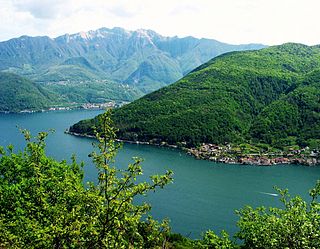
Monte San Giorgio is a Swiss mountain and UNESCO World Heritage Site near the border between Switzerland and Italy. It is part of the Lugano Prealps, overlooking Lake Lugano in the Swiss Canton of Ticino.

Birgeria is a genus of carnivorous marine ray-finned fish from the Triassic period. Birgeria had a global distribution. Fossils were found in Madagascar, Spitsbergen, Germany, Switzerland, Italy, Slovenia, China, Russia, Canada and Nevada, United States. The oldest fossils are from Griesbachian aged beds of the Wordie Creek Formation of East Greenland.

Ticinepomis is an extinct genus of coelacanth lobe-finned fish which lived during the Middle Triassic period in what is now Switzerland. It contains two species, T. peyeri and T. ducanensis.

Whiteia is an extinct genus of prehistoric coelacanth fish which lived during the Triassic period. It is named after Errol White.
Luganoia is an extinct genus of prehistoric bony fish that lived during the Anisian and Ladinian ages of the Middle Triassic epoch. Fossils were recovered from the Besano Formation of Monte San Giorgio and Besano area and from the Zhuganpo Member of Guizhou, South China. It was also reported from the Ladinian of Spain.

Besania is an extinct genus of prehistoric bony fish that lived during the Anisian and Ladinian ages of the Middle Triassic epoch in what is now southern/southeastern Switzerland and northern Italy. Fossils were recovered from the Besano Formation of Monte San Giorgio area and the Prosanto Formation of canton Graubünden, Switzerland.
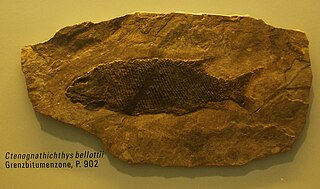
Ctenognathichthys is an extinct genus of prehistoric bony fish that lived during the Anisian and Ladinian ages of the Middle Triassic epoch in what is now southern/southeastern Switzerland and northern Italy.

Heptanema is an extinct genus of prehistoric coelacanth from the Middle Triassic (Ladinian) of northern Italy and southern Switzerland.
Moenkopia is an extinct genus of prehistoric sarcopterygians from the Coelacanthidae found in the Middle Triassic Moenkopi Formation of Arizona. The type, and only species, M. wellesi, was named in 1961 in honour of Samuel Paul Welles. It is only known from the holotype, UMCP 36193, a partial skull consisting only of the basisphenoid that was collected in 1939 or 1940 by Samuel Welles and briefly noted on by him in 1947, and other assorted specimens found before 2005 in the Radar Mesa by S. J. Nesbitt, W. G. Parker and R. B. Irmis.
Sassenia is an extinct genus of prehistoric coelacanth lobe-finned fish that lived during the Early Triassic epoch in what is now East Greenland and Svalbard.
Swenzia is an extinct genus of coelacanthid fish from the late Jurassic of France. It contains a single species, S. latimerae, which was originally described as Wenzia latimerae. Because the generic name Wenzia was already preoccupied by a snail, the generic name was amended to Swenzia. It is the fossil genus most closely related to the living coelacanth, Latimeria.
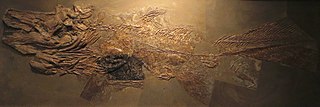
Trachymetopon is an extinct genus of prehistoric coelacanth from the Jurassic of Europe. Fossils have been found in the Early Jurassic Posidonia Shale of Germany the Middle Jurassic Marnes de Dives of France, and probably the Late Jurassic Kimmeridge Clay of England. Only one species has been named, Trachymetopon liassicum, described by Henning in 1951 from an almost complete specimen found in the Lower Toarcian of Ohmden in Baden-Württemberg. Another specimen is known from the same site, and two older specimens come from the Sinemurian of Holzmaden. The holotype of this species is 1.6 metres in length. A giant specimen of an undetermined species of Trachymetopon found at the Middle Jurassic Falaises des Vaches Noires of Normandy. This specimen, composed of a 53 cm long palatoquadrate, belongs to an individual 4 metres (13 ft) in length. A basisphenoid found in a museum in Switzerland that likely originates from the same locaity probably belonged to an individual around 5 m (16 ft) long, making Trachymetopon the largest of all coelacanths alongside Mawsonia. A study published in 2015 revealed that this coelacanth belongs to the Mawsoniidae. Trachymetopon is one of the few known mawsoniids to have been exclusively marine, while most of the other members of the group have lived in fresh and brackish waters.

Bobasatrania is an extinct genus of prehistoric bony fish that survived the Permian-Triassic extinction event. Fossils of Bobasatrania were found in beds of Changhsingian to Ladinian age. It was most speciose during the Early Triassic.
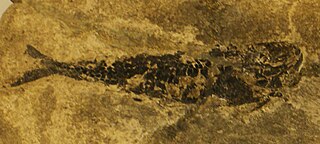
Meridensia is an extinct genus of prehistoric ray-finned fish that lived during the Anisian and Ladinian ages of the Middle Triassic epoch in what is now southern Switzerland and northern Italy. Fossils were recovered from the Besano Formation of Monte San Giorgio and Besano area at the Swiss-Italian boundary.
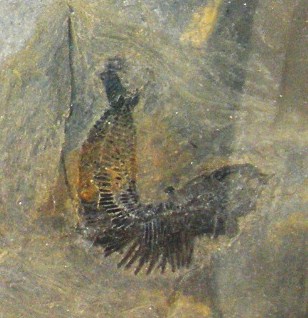
Placopleurus is an extinct genus of prehistoric ray-finned fish from the Middle Triassic epoch of Italy, Slovenia, and Switzerland.
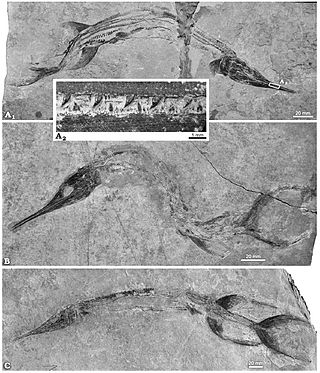
Sinosaurichthys is an extinct genus of saurichthyid ray-finned fish, which existed in southwestern China during the Middle Triassic. Fossils have been found in the Upper Member of the Guanling Formation of two localities: Yangjuan of Panxian County, Guizhou Province, and Dawazi of Luoping, Yunnan Province, China.

Megalocoelacanthus dobiei is an extinct species of giant latimeriid coelacanth lobe-finned fish which lived during the Lower Campanian epoch until possibly the early Maastrichtian in the Late Cretaceous period in Appalachia, the Western Interior Seaway and Mississippi Embayment. Its disarticulated remains have been recovered from the Eutaw Formation, Mooreville Chalk Formation, and Blufftown Formation of Alabama, Mississippi, and Georgia, and also from the Niobrara Formation of Kansas. Although no complete skeleton is known, careful examination of skeletal elements demonstrate it is closely related to the Jurassic-aged coelacanthid Libys. The species is named for herpetologist James L. Dobie. It has been estimated to have been 3.5—4.5 meters in length.

Foreyia is an extinct genus of coelacanth lobe-finned fish which lived during the Middle Triassic period in what is now Canton of Graubünden, Switzerland. It contains a single species F. maxkuhni.





















